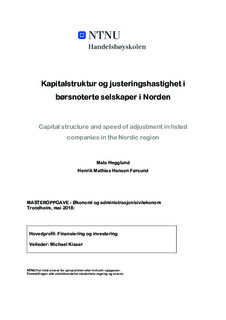| dc.contributor.advisor | Kisser, Michael | |
| dc.contributor.author | Hegglund, Mats | |
| dc.contributor.author | Førsund, Henrik Mathias Hansen | |
| dc.date.accessioned | 2018-12-13T15:05:00Z | |
| dc.date.available | 2018-12-13T15:05:00Z | |
| dc.date.issued | 2018 | |
| dc.identifier.uri | http://hdl.handle.net/11250/2577646 | |
| dc.description.abstract | Denne avhandlingen undersøker hvilke forhold som er med på å forklare kapitalstrukturen i børsnoterte selskaper i Norden, i tillegg til å avdekke hvor fort selskaper justerer sin kapitalstruktur når den avviker fra gjeldsmålet. Utredningen retter fokus mot likheter og ulikheter mellom Norge, Sverige, Danmark og Finland. Vi benytter selskapsspesifikke variabler som fra tidligere forskning har vist seg å forklare observert kapitalstruktur. Videre inkluderer vi makroøkonomiske faktorer for å undersøke om kapitalstrukturen og justeringshastigheten blant selskaper i Norden påvirkes av makroøkonomiske forhold.
Ved å sammenligne flere multiple regresjonsmodeller for landene i Norden individuelt, og Norden samlet, finner vi at lønnsomhet, størrelse, industry leverage, varige driftsmidler og skatt har størst påvirkning på kapitalstruktur. Kapitalstruktur i Norden følger dermed ikke kun én av de fundamentale kapitalstrukturteoriene, men en kombinasjon av disse. Som poengtert av The Economist (The secret of their success, 2013), har landene i Norden i stor grad klart å unngå store økonomiske problemer. Det er likevel interessant å se om selskaper påvirkes ulikt av makroøkonomiske forhold. Funnene våre tilsier at makroøkonomiske forhold og økonomiens tilstand har stor påvirkning på kapitalstruktur i Norden. Resultatene fra våre analyser indikerer at gjeldsandel i Norden er motsyklisk, altså at selskaper har mindre gjeld i perioder med ekspansjon. Likevel finner vi at kapitalstrukturen blant børsnoterte selskaper i Danmark ikke påvirkes i like stor grad som børsnoterte selskaper i Norge, Sverige og Finland. Videre tenderer selskaper i Norden mot å ha lave justeringskostnader, ettersom vi finner en høy justeringshastighet i Norden sammenlignet med tidligere studier på justeringshastighet som fokuserer på andre deler av verden. Justeringshastigheten i Norden avhenger i tillegg av økonomiens tilstand, da selskaper justerer sin kapitalstruktur saktere i perioder med resesjon. Dette indikerer at justeringskostnader øker i lavkonjunkturer. Likevel finner vi store ulikheter mellom landene i Norden. For eksempel øker justeringshastigheten i Danmark i tider med resesjon, noe som viser at danske børsnoterte selskaper ikke påvirkes av makroøkonomiske forhold på samme måte som resten av Norden. | nb_NO |
| dc.description.abstract | -
This thesis examines which factors explain the capital structure of listed companies in the Nordic region, in addition to revealing how fast companies adjust their capital structure when it deviates from the target leverage. The thesis focuses on similarities and inequalities between listed companies in Norway, Sweden, Denmark and Finland. We will use firm specific factors that from previous research has shown to explain the observed capital structure in a satisfactory manner. Furthermore, we include macroeconomic factors to examine if the capital structure and speed of adjustment in the Nordic region is affected by macroeconomic conditions.
By comparing several multiple regression models for the Nordic countries individually, and for the Nordic region overall, we find that profitability, size, industry leverage, tangible assets and taxes to be the most influential determinants of capital structure. Thus, the results imply that capital structure in the Nordic region do not follow one explicit fundamental capital structure theory, but a combination of these. As pointed out by The Economist (The secret of their success, 2013), Nordic countries have managed to avoid major financial problems. However, it’s interesting to investigate if the companies in the Nordic region are affected by macroeconomic conditions. Our findings indicate that macroeconomic conditions and the state of the economy have a major impact on the capital structure in the Nordic region. The results of our analysis indicate that leverage in the Nordic region is counter-cyclical, i.e. firms tend to have less debt during periods of expansion. Nevertheless, we find that the capital structure of listed companies in Denmark is not affected in the same extent compared to companies in Norway, Sweden and Finland. Furthermore, we find that companies in the Nordic region tend to have low adjustment costs, as we find a high speed of adjustment in the Nordic region compared to previous research on speed of adjustment focusing on other parts of the world. The adjustment speed also depends by the state of the economy, as companies adjust their capital structure more slowly in recessions. This indicates that adjustment cost increase in bad economic states. Nevertheless, we find significant differences between the countries in the Nordic region. For example, the adjustment speed in Denmark increases in periods of recession, implying that listed companies in Denmark is not affected by the state of economy in the same way as rest of the Nordic region. | nb_NO |
| dc.language.iso | nob | nb_NO |
| dc.publisher | NTNU | nb_NO |
| dc.title | Kapitalstruktur og justeringshastighet i børsnoterte selskaper i Norden | nb_NO |
| dc.type | Master thesis | nb_NO |
| dc.subject.nsi | VDP::Samfunnsvitenskap: 200::Økonomi: 210 | nb_NO |
